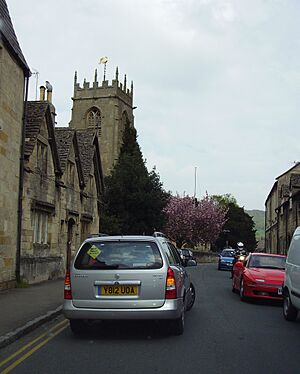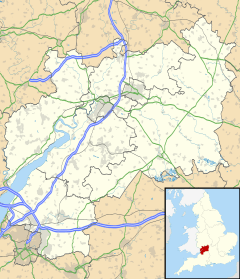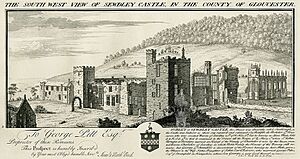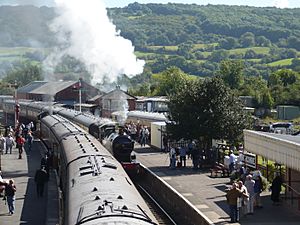Winchcombe facts for kids
Quick facts for kids Winchcombe |
|
|---|---|
 Gloucester Street, Winchcombe |
|
| Population | 5,121 (2021 Census) |
| OS grid reference | SP025285 |
| District |
|
| Shire county | |
| Region | |
| Country | England |
| Sovereign state | United Kingdom |
| Post town | CHELTENHAM |
| Postcode district | GL54 |
| Dialling code | 01242 |
| Police | Gloucestershire |
| Fire | Gloucestershire |
| Ambulance | Great Western |
| EU Parliament | South West England |
| UK Parliament |
|
Winchcombe is a lovely market town and civil parish in Gloucestershire, England. It's about 6 miles (10 km) north-east of Cheltenham. In 2021, about 5,121 people lived there.
This historic town is found in the beautiful Cotswolds area. Many of its buildings and features are very old, some even from the medieval times. Winchcombe also became famous in 2021 when a rare Winchcombe meteorite fell right into someone's driveway!
Contents
Discovering Winchcombe's Past
Winchcombe has a long and interesting history. People have lived in this area for thousands of years.
Ancient Times and Early Settlements
The Belas Knap Neolithic long barrow is a very old burial mound near Winchcombe. It was built around 3000 BCE, which is about 5,000 years ago! This shows that people lived here even in the Stone Age.
Winchcombe in Anglo-Saxon England
During the time of the Anglo-Saxons, Winchcombe was a very important place. It was one of the main communities in a kingdom called Mercia. King Coenwulf of Mercia liked Winchcombe a lot.
For a short time in the 11th century, Winchcombe was even the main town, or county town, of its own area called Winchcombeshire. It's believed that St Kenelm, a saint who was said to be King Coenwulf's son, is buried here.
Medieval Castles and Challenges
In the 12th century, during a time of fighting called the Anarchy, a special type of castle was built. This was a motte-and-bailey castle, which had a mound (motte) with a tower and a walled courtyard (bailey). It was built for Empress Matilda in the early 1140s, but we don't know exactly where it was.
The Famous Winchcombe Meteorite
On February 28, 2021, something amazing happened in Winchcombe. Pieces of a meteorite, which came from the asteroid belt between Mars and Jupiter, fell onto a house driveway!
This meteorite is very special. It's a rare type called a carbonaceous chondrite. This means it contains very old material from when our solar system first formed, about 4.6 billion years ago. Because a local resident quickly found and collected it, the meteorite was kept in great condition. Other pieces were found on a nearby farm. Some of these amazing space rocks are now on display at the town museum!
Exploring Winchcombe's Attractions
Winchcombe has many interesting places to visit, from ancient ruins to fun steam railways.
Historic Buildings and Town Layout
Winchcombe began as a small Roman village. It grew into an important Anglo-Saxon town with walls. It even had Winchcombe Abbey, where a Mercian king and his saintly son were buried.
Even though the town walls are gone, Winchcombe still looks much like it did in medieval times. You can see many buildings made of timber and Cotswold limestone along its High Street. Some of these buildings are from the 15th century!
Popular Spots for Visitors
Winchcombe is a great place for people who love walking and history. It's located on the Cotswold Way, a famous walking trail.
Many visitors also enjoy riding the heritage GWR steam railway. This railway connects Winchcombe with Broadway and the Cheltenham Racecourse. Another popular spot is Sudeley Castle, which is just outside town. This castle is famous as the burial place of Queen Catherine Parr, one of King Henry VIII's wives.
Important Buildings in Winchcombe
Winchcombe and the area around it have some very notable buildings.
Sudeley Castle is a grand castle with a long history. You can also find the remains of Hailes Abbey nearby. This abbey was once a very important place for pilgrimage because it was believed to hold a phial containing the Blood of Christ. Sadly, nothing remains of the original Winchcombe Abbey.
In the center of town, you'll find St Peter's Church. It's known for its interesting grotesques, which are carved stone figures. Many buildings around Sudeley Hill are also listed as Grade II, meaning they are historically important.
Walking Trails Around Winchcombe
Winchcombe is a fantastic place for walkers! Seven long-distance walking paths cross through the town. These include:
- The Cotswold Way
- The Gloucestershire Way
- The Wychavon Way
- St Kenelm's Trail
- St Kenelm's Way
- The Warden's Way
- The Windrush Way
In 2009, Winchcombe joined the Walkers are Welcome network. This means it's a town that really welcomes walkers. Every May, Winchcombe even holds its own walking festival!
Getting Around Winchcombe
You can travel to and from Winchcombe using local bus services. These buses connect the town to Cheltenham, Broadway, and Willersey.
Winchcombe used to have a railway station that opened in 1906. It was part of a main line that connected Birmingham to the South West and South Wales. However, Winchcombe railway station closed to passengers in 1960.
Later, the railway line was taken apart. But in the early 1980s, a part of the line between Toddington and Cheltenham Racecourse was rebuilt. This is now the heritage Gloucestershire Warwickshire Railway, which uses old steam trains. It was even extended to Broadway in 2018. The new station building at Winchcombe was brought from the old Monmouth Troy railway station. Nearby, you can find the Greet Tunnel, which is 693 yards (633 m) long.
Local Government and Community
Winchcombe has its own local government. The town is part of an electoral ward that stretches from Alderton in the north to Hawling in the south.
The Winchcombe Town Hall is now home to the Winchcombe Folk and Police Museum. It's a great place to learn about the town's history and local life.
Schools in Winchcombe
Winchcombe has schools for different age groups.
- Winchcombe School is a secondary school located on Greet Road.
- Winchcombe Abbey Church of England Primary School is near the town center, next to the Winchcombe Library.
Local Media and Radio
People in Winchcombe can get their local news and TV from BBC West Midlands and ITV Central. There are also several local radio stations:
- BBC Radio Gloucestershire (104.7 FM)
- Heart West (102.4 FM)
- Greatest Hits Radio South West (107.5 FM)
- Radio Winchcombe (107.1 FM), which is a community radio station just for the town.
The local newspaper that serves the town is the Gloucestershire Echo.
Community Life and Activities
Radio Winchcombe, the community radio station, started broadcasting full-time in 2012. It's a great way for local people to connect.
Winchcombe also has a very well-known restaurant called 5 North Street, which has been recognized by the Michelin Guide. There are many other nice places to eat in town too.
If you like sports, the local football team, Winchcombe Town F.C., plays in the Gloucestershire Northern Senior League.
Famous People from Winchcombe
Many interesting people have connections to Winchcombe:
- King Coenwulf of Mercia (reigned 796–821) was buried in Winchcombe Abbey.
- Saint Kenelm (c. 786–811), a young king of Mercia, was buried here, making Winchcombe an important place for his followers.
- Ralph Boteler, 1st Baron Sudeley (c. 1394–1473) was a very important official in England and helped build Sudeley Castle and St. Peter's Church.
- Christopher Merret (1614/1615–1695), born in Winchcombe, was a naturalist who made the first lists of British birds and butterflies.
- Emma Dent (1823–1900) was an expert in old things and an author. She helped restore Sudeley Castle and improved many houses in Winchcombe.
- Michael Cardew (1901–1983) was a famous potter who came to Winchcombe to restart an old pottery.
- Ray Finch (1914–2012) was another master potter who bought Michael Cardew's pottery and worked there for many years.
- Cornelius Cardew (1936–1981), a composer, was born in Winchcombe. He was Michael Cardew's son.
See also
In Spanish: Winchcombe para niños





